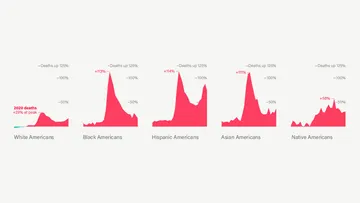In the nine months since this initial report, we’ve learned a great deal more about how racial disparities animate criminal justice systems in Ferguson, Mo. and around the nation. On the anniversary of Michael Brown’s death, here are just a few examples:
Unarmed black men are seven times more likely than unarmed white men to die by police gunfire. Since Michael Brown’s death, at least 24 other unarmed black men have been shot by the police, an average of one about every nine days (The Washington Post). The problem is not just about race, it’s about class, too (The Week). And even though thousands of Americans have been killed by the police over the past decade, only a few of those officers involved in the shootings have been prosecuted (The Washington Post).
Despite changes to police tactics and municipal-court personnel, arrest warrants for petty offenses are spiking in Ferguson after a brief lull this spring (CNN). In the meantime, most post-Ferguson legislation fizzled due to “pushback” from police and prosecutors (The Wall Street Journal).
Ferguson officials still haven’t agreed to the reforms sought by federal officials and have asked for more time to come up with a less-expensive solution (St. Louis Post-Dispatch). Residents say, unsurprisingly, that progress on policing and racial justice has been mixed since last August (The New York Times).
Police shootings of both black and white people are now being counted. The death of Michael Brown in Ferguson and Eric Garner in New York prompted several media outlets to generate a count of the number of men and women in America killed by the police each year. The Guardian, for example, now has a standing feature called “The Counted,” that today stands at 704 (The Guardian). Vice puts the total number of Americans killed by the police since Michael Brown died at 1,083 (Vice).
Jim Crow was still alive when Americans began to grapple more seriously with the racial disparities of their criminal justice systems. The problem of “black justice” versus “white justice” has erupted sporadically since the Civil Rights era. But in the aftermath of the Michael Brown shooting in Ferguson, Missouri, a string of reports have revealed some striking discrepancies:
You really can get pulled over for driving while black. Federal statistics show African-American drivers are 31 percent more likely to be pulled over than whites. They are more than twice as likely to be searched by the police. And they are nearly twice as likely to not be told a reason for the traffic stop. (The Washington Post)
African-Americans are far more likely to be arrested than whites. In Ferguson, the police have arrested blacks at a rate three times that of other races. But that figure is hardly exceptional: In at least 70 police departments around the country, the arrest rate for blacks was 10 times that of non-blacks. (USA Today)
Many police departments don’t match the racial diversity of their communities. A survey from 2007 of the nation’s largest cities shows that a small proportion of police departments replicate the racial makeup of the populations they serve. In hundreds of police departments across the country, the percentage of white officers is more than 30 points higher than in the communities they serve, a government survey shows. (The New York Times)
St. Louis County is a prime example of that racial disparity. In St. Louis County, the police force is 10 percent black, whereas the population is 25 percent black. In Ferguson, 67 percent of residents are black; 7 percent of cops are. (St. Louis Post-Dispatch)
Drug use is the same among blacks and whites. Arrests for drug use are not. In these cases, your odds of being arrested are 3.6 higher if you’re black. (Vox)
Black teenagers are far more likely to be killed in police shootings than white teenagers.
Over the last 40 years, blacks are, on average, 4.2 times more likely than whites to be killed in police shootings. (Mother Jones)
More recently, federal data show that of 1,217 deadly police shootings between 2010 and 2012, black males between the ages of 15 and 19 were killed at a rate of 31.17 per million. For white teenagers, the rate was just 1.47 per million. (ProPublica)
These problems have been with us for a long time. In 1967, after riots in Newark and Detroit, a panel convened by President Johnson, the so-called Kerner Commission, produced the Report of the National Advisory Committee on Civil Disorders. In one chapter, it identified the “abrasive” relationship between the police and minority communities as being the source of tension, warning: “To pursue our present course will involve the continuing polarization of the American community and, ultimately, the destruction of basic democratic values.”
